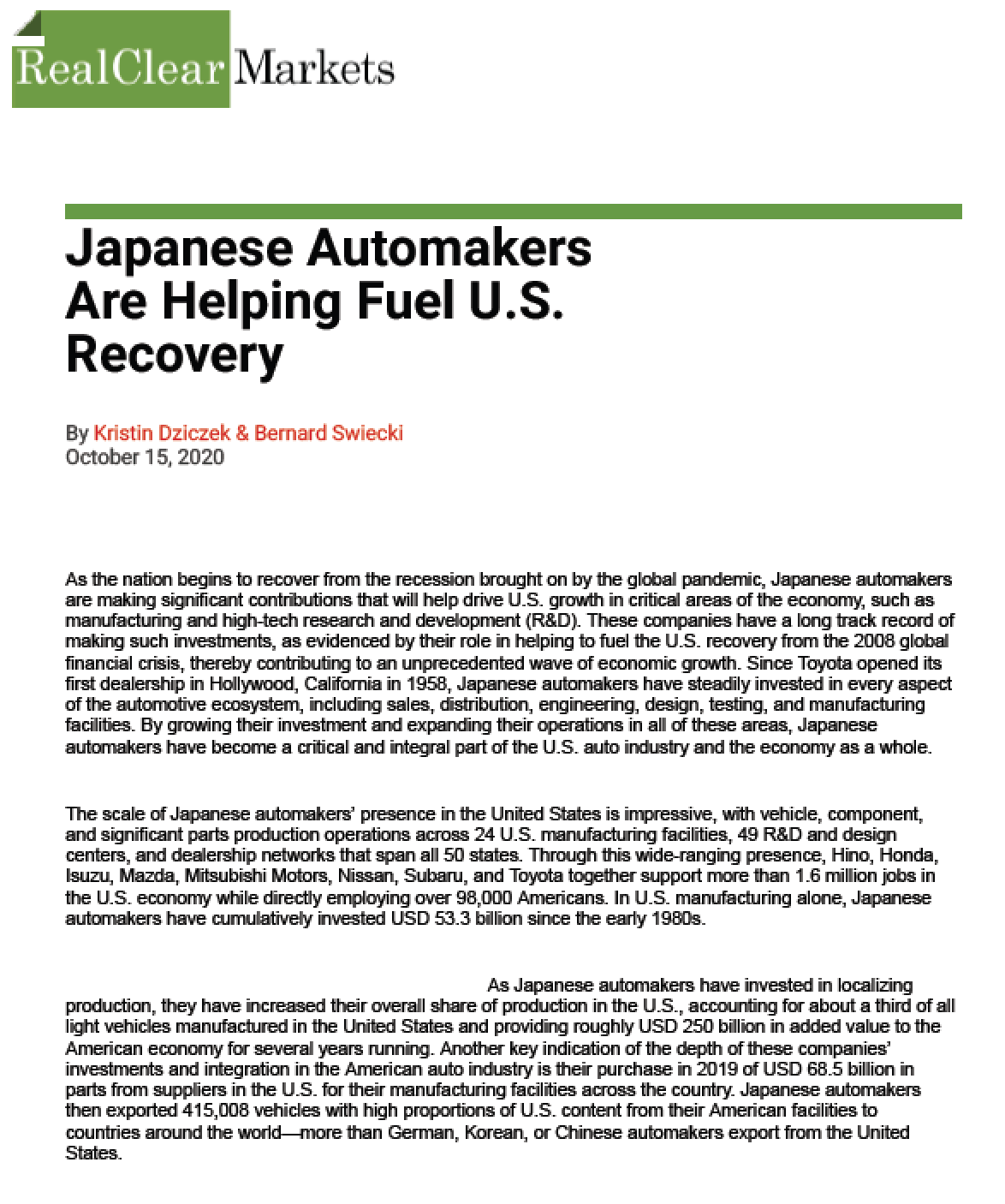Kristin Dziczek & Bernard Swiecki
RealClearMarkets
October 15, 2020
As the nation begins to recover from the recession brought on by the global pandemic, Japanese automakers are making significant contributions that will help drive U.S. growth in critical areas of the economy, such as manufacturing and high-tech research and development (R&D). These companies have a long track record of making such investments, as evidenced by their role in helping to fuel the U.S. recovery from the 2008 global financial crisis, thereby contributing to an unprecedented wave of economic growth. Since Toyota opened its first dealership in Hollywood, California in 1958, Japanese automakers have steadily invested in every aspect of the automotive ecosystem, including sales, distribution, engineering, design, testing, and manufacturing facilities. By growing their investment and expanding their operations in all of these areas, Japanese automakers have become a critical and integral part of the U.S. auto industry and the economy as a whole.
The scale of Japanese automakers’ presence in the United States is impressive, with vehicle, component, and significant parts production operations across 24 U.S. manufacturing facilities, 49 R&D and design centers, and dealership networks that span all 50 states. Through this wide-ranging presence, Hino, Honda, Isuzu, Mazda, Mitsubishi Motors, Nissan, Subaru, and Toyota together support more than 1.6 million jobs in the U.S. economy while directly employing over 98,000 Americans. In U.S. manufacturing alone, Japanese automakers have cumulatively invested USD 53.3 billion since the early 1980s.
As Japanese automakers have invested in localizing production, they have increased their overall share of production in the U.S., accounting for about a third of all light vehicles manufactured in the United States and providing roughly USD 250 billion in added value to the American economy for several years running. Another key indication of the depth of these companies’ investments and integration in the American auto industry is their purchase in 2019 of USD 68.5 billion in parts from suppliers in the U.S. for their manufacturing facilities across the country. Japanese automakers then exported 415,008 vehicles with high proportions of U.S. content from their American facilities to countries around the world—more than German, Korean, or Chinese automakers export from the United States.
Many of the vehicles the Japanese automakers sell in the United States weren’t just built here—they were designed and engineered in R&D and design facilities located across 11 U.S. states. As part of their R&D efforts, Japanese automakers are partnering with automakers from the United States and around the world, as well as with U.S. universities, non-profit organizations, and cutting-edge technology startup companies. Working together with these partners, Japanese firms are developing future technologies that will be critical to keeping the United States globally competitive in the future. As the automotive industry continues to develop Advanced Driver Assistance Systems (ADAS) and, ultimately, fully automated vehicles, Japanese automakers are playing a critical role in keeping the United States on the leading edge of these technologies.
Developing and producing vehicles with this kind of technology requires a highly-trained and flexible workforce. Japanese automakers therefore support and work closely with institutions ranging from top universities to grade schools throughout the United States to promote a variety of critical disciplines, including Science, Technology, Engineering, and Mathematics (STEM), and other fields related to manufacturing quality, productivity, and safety. The students who benefit from these programs go on to work throughout all sectors of the U.S. economy, further helping to make the United States more globally competitive.
Japanese automakers’ U.S. presence also increases the competitiveness of virtually all forms of manufacturing as well as numerous other sectors of the economy. One of their most significant contributions in this regard is the Lean Manufacturing System (LMS), developed by Japanese automakers and subsequently widely adopted not just by other automotive manufacturers, but by companies ranging from banking to healthcare as well as non-profits and government institutions.
Additionally, Japanese automakers provide significant support to non-profit organizations, charities, educational organizations, cultural institutions, and events in their communities. This support is not just financial but also includes providing employees with paid volunteer time. Most recently, these philanthropic efforts have supported critical relief efforts to address the COVID-19 crisis. As integral members of the communities in which they operate, Japanese automakers have stepped in to produce and donate Personal Protective Equipment (PPE) as well as to support a wide array of relief programs.
In a recent study conducted by the Center for Automotive Research, we illustrate how, over a span of five decades, Japanese automakers have grown their commitment to the United States with a track record that goes well beyond their manufacturing facilities. Japanese automakers’ collaboration with American automakers, suppliers, educational institutions, and various other organizations have helped to make the United States more globally competitive across our economy. As a result of these contributions, Japanese automakers have become an interwoven part of the fabric of the U.S. automotive industry and overall economy, and they are instrumental in supporting the ongoing recovery amid the most challenging public health, safety, and economic circumstances of the 21st century.


